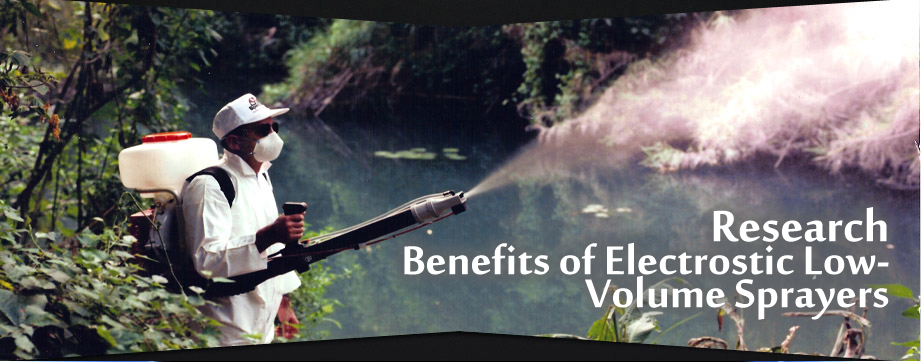

Home>>Company>>Research >> Evaluation of Electrostatically... Evaluation of Electrostatically-charged Sprays for Black Sigatoka Control in Bananas with Motorized Mistblowers. Luis F. Durán, J. Mauricio Rivera C. y Francisco J. Díaz Department of Plant Protection. FHIA, La Lima, Honduras
Clear differences among treatments started to show up by day 56 after treatment initiation. At plant “shooting” time (flower emission) the values of Total Number of Leaves (TL), Number of Functional Leaves (FL) and Youngest Leaf Spotted (YLS) recorded for Spectrum 3010® with charge, Spectrum 3010® w/o charge, and for the Control were, respectively, of 13.15, 12.84 and 11.83 TL; 12.82, 12.14 and 11.03 FL; and 8.83, 8.63 and 7.49 YLS. Those values corresponded to improvements of the charged and uncharged versions of Spectrum 3010® head over the Control, respectively, of +11.1 and +8.5 % for TL, +16 and +10 % for FL, and +17.9 and +15.2 % for YLS. Apparently the improvement in BS control was the result of a combination of electrostatics and, most likely, a compounded effect of the rectangular shape of the head at its end and also of the particular vertical fan shape that acquires the air stream coming out of the rectangular outlet. In fact, it would seem that, under the conditions of this trial, the last two components could have had a more important contribution than electrostatic to the beneficial effect observed in BS control when using the Spectrum 3010® spray head. There were no significant differences among treatments as it concerns to leaf coverage and droplet density as determined in Leaf No. 3, and the results were not that clear. We feel now that the results using the fluorescent tracer and reading Leaf No. 3 should be considered with reserve since, unlike the BS assessment that represents the overall condition of the plant for it involves reading all of the leaves, reading Leaf No. 3 provides only a very partial evaluation of the condition of the whole plant, some of which get to have as many as 14 leaves. Table 1. Mean values of severity of Black Sigatoka and efficiency of its control recorded in plots of bananas cv. Williams subjected to treatments with the electrostatic spray head Spectrum 3010®. CEDPRR, FHIA, La Lima, Honduras. 2006-2007.1
1 Means in the same column followed by different letters are significantly different according to Fisher’s LSD test (p = 0.05) 2 The percentage value of efficiency represents the variation in the sanitary condiction of the particular treatment in relation to the condition of the leaves determined in the Standard treatment in the period of the evaluation.. 3 Period 1: 23-sep thru 23-nov/07; Period 2: 24-nov/07 through 17-ene/08; Period 3: plant shooting time. Each value represents the mean of several consaecutive assesments performed during the corresponding period. Table 2. Mean values and efficiency of leaf coverage and droplet density of the spray deposit determined in the upper and lower side of samples of leaf No. 3 of bananas plants cv. Williams subjected to treatments with the electrostatic spray headSpectrum 3010®. CEDPRR, FHIA, La Lima, Honduras. 2006-2007. 1
1 Means in the same column followed by different letters are significantly different according to Fisher’s LSD test (p = 0.05) 2 Droplet density assessment scale where 1 = absence, 2 = traces, 3 = light to moderate, 4 = satisfactory, 5 = good, 6 = overapplied, 7 = saturated 3 The percentage value of efficiency represents the variation in coverage and droplet density in Leaf 3 of the particular treatment in relation to the condition determined in the Standard treatment.
|
||||||||||||||||||||||||||||||||||||||||||||||||||||||||||||||||||||||||||||||||||||||||||||||||||||||||||||||||||||||